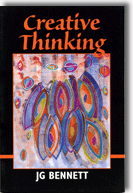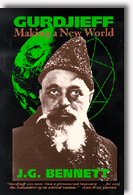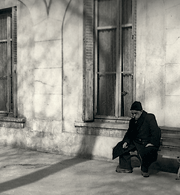Description
Trade Paperback • perfect bound • 72 pages • rare • last two copies
In Creative Thinking Bennett elucidates the conditions necessary for creative insight, emphasizing the pattern of effort and non-effort that is effective. This book is not to be read passively; it involves the reader, inviting us to work with the techniques suggested. Relevant to artists, musicians, and problem-solvers, as well as to anyone who wishes to bring creative forces into one’s life, Creative Thinking offers a doorway to one’s own visions of reality, to new solutions to problems, and to a fresh and keener mind. At its core is the secret of how to astonish oneself.
J.G. Bennett=Author
Review by Pierce Butler
DESCRIPTION:
This book, based on a 1964 course given in London, presents a systematic approach to problems requiring creativity that at the same time takes into account the complexity of individual experience. Mr. Bennett, a scientist and spiritual practitioner, represents the creative process as composed of three essential elements: a thorough familiarity with the material, the essential element of spontaneity, and a knowledge of the appropriate technique. His unique contribution lies in his approach to spontaneity or creativity. This approach draws on the tradition of the zen koan and on the teaching of G. I. Gurdjieff, but Bennett makes it accessible by emphasizing the potential connection between creativity and practice. In effect, he gives us a way of courting creativity, a set of techniques which if practiced diligently can open up possibilities that at the outset seem to belong only to exceptional individuals.
Having presented the three indispensable conditions of the creative process, Mr. Bennett proceeds to outline a complex epistemology, drawing on his research for his chief work, The Dramatic Universe. The outline describes the conditions for “real thinking” (which is different from our usual understanding of the term) and goes on to examine the role played by the various kinds of energies-automatic, sensitive, conscious, and creative-in the process of problem-solving. He emphasizes the critical distinction between sensitivity and consciousness-sensitivity is simple awareness whereas consciousness entails the presence of an observer-and the need to activate the higher energies in the solution of problems that cannot be solved by competence alone. He provides suggestions for the development of the sensitivity through methods such as visualization that enable the connections with the higher energies of consciousness and creativity The book culminates in a detailed description of practical rules for creative work and some hints for making contact with creativity in group work.
QUOTATIONS:
–“The way to think is not to think.”
–“Real thinking is the spontaneous arising, in the inner awareness, of an image that gives us a contact with some part of reality.”
–“There are problems which are intractable on the level of sensitivity, which can be solved on the level of consciousness. In this state they are not solved by bringing in anything which was not there before, but by seeing connections, and meaning, and significance, that we did not see before.”
–“The conscious energy is not a contact with things as they really are; it is really a deeper contact with oneself that makes things matter to one in a much sharper and intense way.”
–“[The] chief characteristic [of the creative energy] is that it unites directly with things as they are instead of having to pass through some kind of transmission mechanism.”
–“The work of a group which is committed to the task of creative thinking usually arises through some very powerful need or very powerful stimulus, which overcomes all the conditioning and limitations of the lower levels of our experience.”
TABLE OF CONTENTS:
I. Living in the Medium: three conditions of creativity; assembling the information; asking the question; technique.
II. Real Thinking: real thinking is spontaneous; the sensitive screen; stopping verbal activity; conditions of spontaneity; postures, habitual influences, quieting the mind.
III. The Levels of Energies: life as transformation of energy; automatic, sensitive, conscious, creative energies; sensitivity and consciousness; the creative energy; connections between energies.
IV. The Organization of the Sensitivity: the mind as sensitivity; professional competence and automatism; training the sensitivity; visualization.
V. Practical Rules for Creative Work: seeking information; asking the question; commitment; confidence; the state of emptiness.
VI. Group Creativity: creativity as play; education; groups and problem-solving.
WHO SHOULD READ:
While this is a book for anyone who has ever cooked a meal or undertaken a household project, it will be of special interest to artists, scientists, and professionals in a variety of fields whose work requires a kind of contact with creativity that is not easy to elicit. Fourth Way practitioners will find invaluable guidance in many inner practices, including visualization and meditation.
QUESTIONS:
–What is creativity?
–What is real thinking?
–How can I train my mind to be more receptive to the creative impulse?
–How can creativity play a greater role in our professional work and in our artistic and scientific projects?
CONNECTIONS/RELATED WORKS:
The Dramatic Universe, Volume II: The Foundations of Moral Philosophy (Chapter 32: Energies)
Elementary Systematics
Energies: Material, Vital, Cosmic (Out of Print)
How We Do Things: The Role of Attention in Spiritual Life (Out of Print)
A Spiritual Psychology





